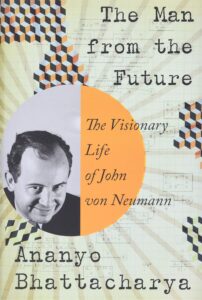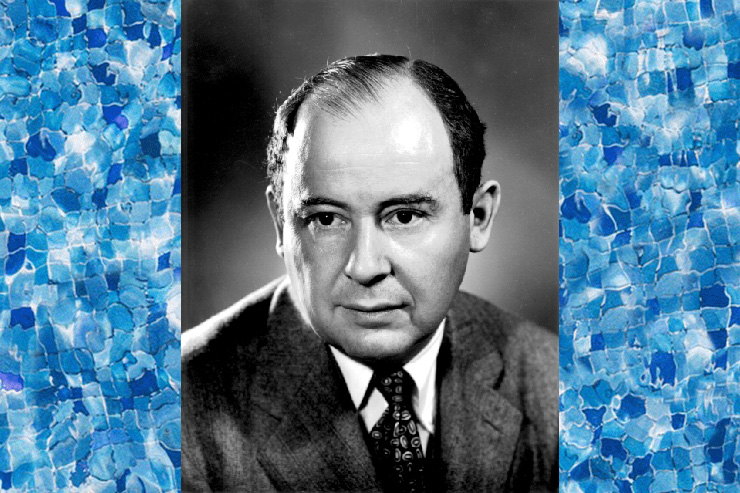
The Man from the Future
by Ananyo Bhattacharya
W. W. Norton
368 pp., $30.00
It is a brave author who attempts a biography of Hungarian mathematician John von Neumann (1903–1957). The business of a biographer is to give us both the man and his work. The man, for any author well-acquainted with human nature, should not present much difficulty. Von Neumann’s work, however, was at the very highest levels of human intellection in math and physics, with direct consequences in fields as disparate as nuclear weaponry and economics.
To give a fair account of von Neumann’s work to a lay reader is therefore a daunting challenge. So far as I know, Ananyo Bhattacharya’s is the first attempt in English since Norman Macrae’s 31 years ago. Macrae was an economist, in fact an editor at The Economist, and well-equipped to describe von Neumann’s contributions to that discipline. Macrae confessed, however, that most of von Neumann’s math and physics was beyond him and that he had been helped by friends qualified in those fields.
Bhattacharya is a physicist. He knows the relevant math and science, which is a great help in explaining von Neumann’s work. Such knowledge tempts the biographer, however, to give us too much of the work and not enough of the man. To put it as positively as I am able, Bhattacharya has not skimped on describing the content, prior history, and subsequent development of von Neumann’s main interests.
The book’s last chapter, covering von Neumann’s final decade, is much too long. Von Neumann’s primary focus in those last years was summed up in the title of his posthumous book, Theory of Self-reproducing Automata (1966). Strikingly few practical results have come from these 70-year-old cogitations in comparison to the swift and lasting impact of von Neumann’s earlier work in nuclear weapons and computing. Where are the self-building moonbases?
So who was John von Neumann? He was of Ashkenazi-Jewish lineage and therefore belonged to that human stock which, of all that are known, has the highest mean IQ. To be a high-IQ outlier among the Ashkenazim is to be an outlier indeed.
Furthermore, von Neumann had the good fortune to be raised in a time and place—the Hungarian belle époque of the years around 1900—in which the Ashkenazim had unlimited freedom to express their talents. Hungary had been granted autonomy from Austria in the Compromise of 1867 and was a more-or-less equal partner in the resulting dual monarchy. The ruling emperor-king of Austria-Hungary was Franz Josef I, a philo-Semite. “I will not tolerate Jew-baiting in my empire,” Franz Josef told his ministers more than once. Von Neumann’s father, Max, an investment banker, was granted a hereditary title by Franz Josef for services to the national economy: hence the “von,” although Max did not use it.
John von Neumann was recognized as a prodigy as soon as he could speak. He breezed through his elementary and high-school education with top grades in all but physical education, music, and handwriting.
His staggering intellect aside, von Neumann was in adult life perfectly normal, with none of the geeky weirdness of Paul Erdős or the mental instability of Kurt Gödel. He was well-groomed and dapper. Bhattacharya’s book contains nine photographs in which the adult John von Neumann can be identified: he is wearing a suit in every one, a tie in eight. He had the manners of a gentleman and took criticism well. Uncommonly for a mathematician, he had no interest in music. Even more counterintuitively (but consoling to us duffers) he was only an average chess player.
Von Neumann was in fact something of a bon vivant. As a lecturer at the University of Berlin in 1927-29, he enjoyed that city’s legendary night life. He met his second wife in a Monte Carlo casino when he was “seated at one of the more modestly priced roulette tables.” (He had a system, of course.) The couple’s parties at Princeton were famously lively. Von Neumann’s automobile of choice was a Cadillac.
In politics, he was conservative and in the early Cold War years took a strong line against the Soviet Union in all the many defense-related consulting positions he held. As a teenager in Budapest, he had lived through Béla Kun’s brief but nasty Leninist regime, and the experience inoculated him for life against communism.
When his leftist friend Robert Oppenheimer, under suspicion of being a security risk, was summoned in 1954 to secret hearings of the Atomic Energy Commission (AEC), von Neumann defended Oppenheimer vigorously, though unsuccessfully. And when, the following year, von Neumann himself accepted a position on the AEC, his leftist colleagues were very critical. Oswald Veblen, the American mathematician and atomic physicist, never forgave him.
Von Neumann’s family were not observant Jews. When Max died in 1929, they converted to Roman Catholicism; but religion played little part in John’s life until his sad final days, when he was hospitalized with bone cancer. He then took instruction from the hospital’s Catholic priest. With proper respect to a fellow mathematician 300 years his senior, he also told his daughter that he conceded the point of Pascal’s wager.
So much for the man. What about the work? Mathematicians traditionally divide their subject into “pure” and “applied.” When practicing pure mathematics, they take delight in abstract ideas that appear in our minds “as if summoned from the void,” in the words of the French mathematician Alexander Grothendieck. Applied mathematicians use those ideas as tools with which to study the natural world and solve practical problems: the motions of the planets, the generation of electricity, the most effective way to fire an artillery shell.
The border between pure and applied is not always clearly marked, and there are flows from one side to the other. What is the purest of pure intellection to mathematicians of one generation may find practical relevance a hundred years later, while pondering the motions of solid bodies may lead to concepts taken up and brought to full flower by pure mathematicians, as happened with calculus.
Von Neumann moved effortlessly between the pure and the applied realms. There are at least 52 concepts, theorems, and conjectures named after von Neumann, two more than are named after Einstein. Von Neumann’s doctoral thesis, submitted when he was 22, was on the axiomatization of set theory, a subject that involves questions about the nature of mathematical truth, whether propositions can always be rigorously proven either true or false, and that attempts to define the most fundamental concepts. This, the purest of pure math, was a key area of research in the 1920s.
The frontier of physics at that time was quantum theory, which was badly in need of mathematical help. Turning to the applied side, von Neumann published, at age 28, Mathematical Foundations of Quantum Mechanics, a book in which he aimed to show that quantum mechanics arises naturally from the properties of a highly abstract pure-mathematical object called Hilbert space.
How abstract is Hilbert space? If you think four-dimensional space is a stretch, try imagining a space with infinitely many dimensions. It’s not as hard as it sounds: Pythagoras’ Theorem, for instance, can be put to useful work in Hilbert space. After explaining this to my own undergraduate class in functional analysis, Prof. Kestelman chortled, “Pythagoras would have sacrificed a chicken if you’d shown him that!”
By the early 1930s, von Neumann was known worldwide as a genius. Naturalized as a U.S. citizen in 1937 and convinced there would soon be a European war, he became a consultant to the U.S. Army’s Ballistics Research Laboratory, in Maryland. Other defense-related appointments followed. When, in 1942, the Manhattan Project was launched, he was inevitably drawn in and made key contributions to the design of the first nuclear weapons.
Simultaneously, von Neumann collaborated with the economist Oskar Morgenstern on a book about the mathematics of games. Their classic 1944 book, Theory of Games and Economic Behavior, attempted to mathematically determine optimal strategy given the stakes, odds, rules, and likely behavior of opponents.
Von Neumann’s military work had involved great masses of numerical computation. Those efforts turned his thoughts to mechanized computing and plans for an advanced machine to be called EDVAC, the Electronic Discrete Variable Automatic Computer. His June 1945 paper, “First Draft of a Report on the EDVAC,” is the foundational document of modern computer science. The internal organization of computers has ever since been based on prescriptions in that paper—the “von Neumann architecture.”
In the postwar years, von Neumann worked on issues of complexity and on machines that can replicate themselves, the latter leading to his being considered the father of the computer virus.
All of that, and more, is described as well as it can be by Bhattacharya. I put down this book knowing much more about cellular automata than I had before. About John von Neumann the man, though, I was very little wiser.

Leave a Reply